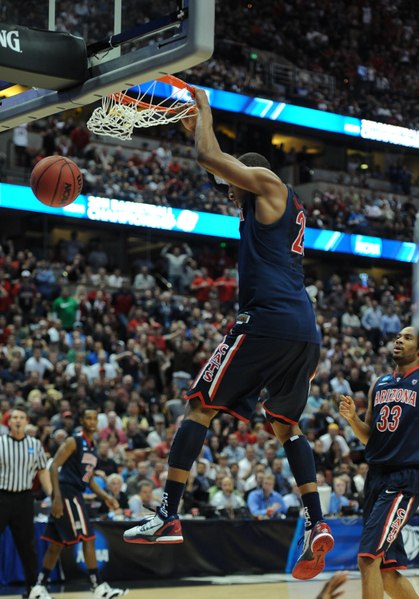Posted by Brian Otskey on June 16th, 2011

Throughout the summer RTC contributors Zach Hayes and Brian Otskey will discuss the hot topics — or whatever comes to mind — around each major conference in college basketball. Our second edition features the Big 12, a conference still fairly strong at the top but undergoing some major changes elsewhere. For the entire summer series focusing on each of the six power conferences, click here.
Brian: About this time last summer, the Big 12 appeared to be on the precipice of extinction. Colorado had accepted an invitation to join the Pac 10 (now Pac 12) and Nebraska departed immediately thereafter to join the Big Ten. With Texas strongly leaning towards jumping ship for the Pac 10, long time Big 12 basketball goliath Kansas, along with four other member schools, was going to be left out in the cold by the machine that is big time college football. Thanks to a last-ditch effort by conference commissioner Dan Beebe, the Big 12 was saved and will continue on with 10 members. While football drives the bus in collegiate athletics, Beebe enhanced Big 12 basketball by cutting some dead weight and keeping Texas in the fold. By dangling the carrot of a Longhorn television network in front of the Texas brass, the Big 12 as we know it was saved for the foreseeable future. This coming season marks the beginning of a new era in Big 12 basketball history. Gone are Colorado and Nebraska, the 16-game unbalanced schedule, a multitude of players from top teams and four coaches who have moved on, some for better and some for worse. In 2011-12, the Big 12 conference welcomes four new head coaches, each inheriting a unique situation and an 18-game round-robin schedule where all 10 league teams will play each other twice both at home and on the road. Frank Haith and Billy Kennedy will take over for Mike Anderson and Mark Turgeon at Missouri and Texas A&M respectively, inheriting rosters built for immediate success, while Lon Kruger and Billy Gillispie have major rebuilding jobs ahead of themselves at Oklahoma and Texas Tech after their predecessors were forced out.

Self Has Reached the Mountaintop Numerous Times in the Big 12
For the last seven seasons, the path to the conference title has gone through Lawrence, Kansas. The Jayhawks should be the favorites until proven otherwise but there is a strong case to be made for a different team to capture the Big 12 crown for the first time since 2004. Who that team could be, however, is up in the air. Texas seemed to be the one at first but the NBA draft and graduation have severely hurt the Longhorns. Rick Barnes welcomes stud recruit Myck Kabongo and five other newcomers but I’m not sure that will be enough to vault Texas to the top of the league standings. Baylor may be the most talented team in this league after Perry Jones’ surprising decision to return to school but persistent questions at the point guard position and off-court distractions for Jones could prevent the Bears from reaching new heights. Missouri returns a loaded roster but Frank Haith was not the most inspiring hire after Mike Anderson left for his dream job at Arkansas. The Tigers have tons of talent and one of the best home court edges in the country but a dismal end to last season coupled with the difficult adjustment from Anderson’s “40 minutes of hell” to Haith’s more disciplined system give me doubts about this team’s ability to win a conference title. Texas A&M returns budding star Khris Middleton along with David Loubeau but I’m not sure that’s enough to win a regular season championship. Jamal Branch will be a terrific addition but the Aggies aren’t deep enough in my estimation.
In short, this is a conference going through a major transition period. It will still be very good but I wouldn’t expect an elite Big 12 like we’ve seen in some years past. The race for the conference title will be fascinating with many teams in the mix but I’d still favor Kansas despite major personnel losses in Lawrence. Do you see any of these teams finally jumping the Jayhawks? Can someone from the bottom half of the league (maybe Oklahoma State) take advantage of the uncertainty and make a significant leap into the top half?
Zach: We really are entering a new era in the Big 12. There’s a different coach pacing the sidelines in Columbia, College Station, Lubbock and Norman. There’s a shiny new round-robin schedule that provides the fairest way to determine a league champion. Perennial bottom-feeders Nebraska and Colorado have moved on, rendering this league even more difficult to navigate top to bottom. Players that lined all-league teams from a season ago — Tristan Thompson, Marcus Morris, Jacob Pullen, Jordan Hamilton, Alec Burks, Lace Dunn — are long gone. Kansas and their seven consecutive Big 12 titles appear more vulnerable in 2011-12 than any other year during that commendable stretch. There are more questions than answers when you survey the conference landscape creating intriguing possibilities.
Read the rest of this entry »
| get to the point, Regular Features
| Tagged: baylor, iowa state, kansas, kansas state, missouri, oklahoma, oklahoma state, texas, texas a&m, texas tech
Share this story




















































